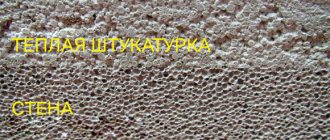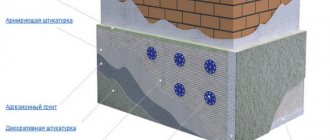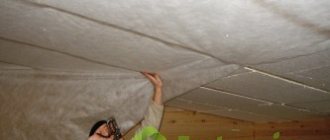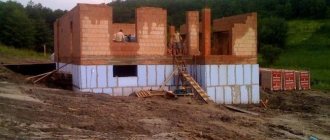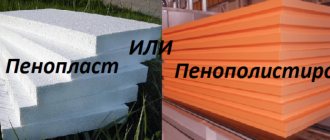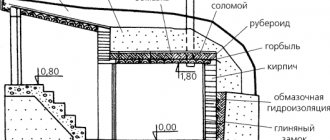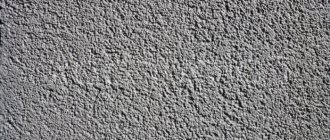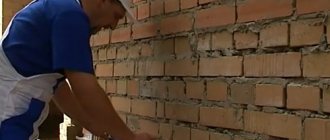Is it possible to insulate the ceiling with polystyrene foam yourself?
The standard scheme for attaching the foam layer is as follows:
- Waterproofing film.
- Reinforcing layer (ideally basalt mesh).
- Polystyrene foam (attached either with dowels or on a polyurethane layer).
- Plaster (applied on top to protect the foam from pests). What is needed is a soil base.
- Decorative finishing (plasterboard, plastic panels, suspended or suspended ceilings, whitewashing, painting).
The only difficulty that will arise after insulating the ceiling with foam plastic is the increasing humidity inside the room. The problem can be solved quite simply - by installing forced ventilation or an air conditioner that can regulate the humidity inside the room.
If this is not done, moisture condensation will begin to accumulate in the layer between the foam plastic and the waterproofing film (since it is warm inside the room in winter, and the wall itself is cool). Naturally, this will lead to the appearance of fungus and mold. Over time, it will spread not only along the ceiling, but also to the walls. Violation of this technology has repeatedly led to the fact that after repair the wallpaper had to be completely re-glued after 3-5 months, since they all turned black.
Frame method
In order to secure foam plastic boards to the ceiling in this way, you will need to assemble a special frame. It can be a lathing made of wooden blocks or a base assembled from aluminum profiles. Aluminum is stronger and therefore preferable. If bars are used, they must be pre-treated with antiseptic impregnation to prevent the appearance of fungus and mold.
The frame is easy to assemble. First, the long components of the frame are fixed along the entire length of the ceiling, in increments of 50 or 60 centimeters - depending on the width of the slabs. After this, again, in accordance with the dimensions of the foam parts, the short transverse parts are attached. The plates themselves are inserted into the resulting cells and secured in them using screws or glue.
After all structural elements are fixed in place, the cavities and gaps between the individual elements are filled with polyurethane foam. It can also be used as an adhesive that fixes the slabs in the frame. If the seams and joints are very thin, you can use a sealant that does not corrode the foam instead of foam.
Ceiling insulation with foam plastic: advantages and disadvantages
Why should the ceiling be insulated with foam plastic from the outside of the house? Because in this case the ceiling part will not freeze. Accordingly, the interior of the room will be protected from the cold by both the thermal insulation material (in this case, foam plastic) and the roof covering itself (if we are talking specifically about the attic, that is, a residential attic). If you insulate from the inside, then the outer covering will freeze at a very low ambient temperature; accordingly, only that very layer of foam will protect the room from the cold.
Why is it recommended to use polystyrene foam?
Because he has:
- excellent soundproofing and thermal insulation qualities (a 10-centimeter layer corresponds to approximately a 1-meter layer of red brick);
- low weight;
- low cost;
- ease of installation.
The only drawback of polystyrene foam is its low resistance to moisture. If the material is moistened, it loses almost all of its thermal insulation qualities, and over time it can become moldy.
It is for this reason that insulation by simply gluing polystyrene foam onto the same polyurethane glue is not allowed.
Will a foam insulation layer protect against the cold if it is attached from the inside? Yes, and quite effectively. But before this, it is recommended that the ceiling itself be thoroughly treated with pesticide components, which will prevent the appearance of mold, rot, and fungus.
Mounting options
Depending on what role the fixed foam will play, you can choose one of several ways to fix it to the ceiling. Most often, the following fastening methods are used:
- Frame. With this method, a special frame is assembled to fix the foam panels. It will serve as the foundation that will hold them.
- Glue. All elements are simply glued to the surface of the ceiling with special adhesives. It is very important to choose the right glue - the strength of the structure depends on it.
The frame method is more suitable for creating an insulating layer, and the adhesive method is more suitable for fixing various foam coatings.
Insulating the ceiling with polystyrene foam from the inside with your own hands
If we are talking about insulation in a private house, then the first thing you need to clarify is whether a layer of foam plastic will help retain heat inside the room. For example, this will be pointless on the ground floor of a two-story house, since it is already warm above (if heating is installed there). In fact, foam plastic in this case will only protect against noise, but it is much easier to replace it with the same acoustic panels or just mineral wool fiber, only a few centimeters thick - this will be enough.
If there is no second floor, and there is an unheated attic above, then a layer of polystyrene foam will be relevant. It is advisable to attach it from the outside, but if this is not possible, this is done from the inside (for example, if we are talking about an apartment in a multi-story building, which is located on the highest floor, and there is a roof immediately on top).
First of all, the ceiling is cleared of finishing to the capital level (concrete slab, brick, wooden beam). Next, pesticide treatment is performed. For this purpose, special solutions are used, which are filled with a regular sprayer and applied to the base under high pressure. You should not forget about the basic rules of protection from chemical reagents, since pesticides have a medium toxicity class.
After treatment, it is recommended to stop repairs for 2-3 days, while periodically ventilating the room. This should be done even if the pesticide manufacturer claims that it is not toxic to the human body in any way.
After all this, you can begin to insulate the ceiling with your own hands. The first step is to install the waterproofing film. This can be either ordinary polyethylene or combined multi-layer moisture protection. Of course, the second option will be preferable. Such panels are fastened with dowels, but it is better to use flea screws, which do not have caps as such and are screwed in to the end of their level. They leave no protruding parts, which will not damage the foam in the future.
The foam itself can be attached to the waterproofing on top. Its permissible thickness is in the range from 5 to 15 centimeters. There is no need for more for living space, and even insulation from the inside. It is also attached with dowels or polyurethane glue. Experts recommend performing a combination of these methods. That is, first strengthen it with glue, and then reinforce it all with dowels on top.
Next, a reinforcing mesh is pressed into the foam. Basalt fabric is best suited for this. It can be fastened over the entire plane using an ordinary construction stapler. The main thing is not to skimp on the staples.
Now all that remains is to apply a primer over the entire area of the insulated ceiling.
There are several options for it:
- primer paint;
- layer of plaster (1-2 centimeters);
- rough drywall (fixed with glue);
- special protective emulsions for ceilings.
The preferred option is ground plaster. It lasts the longest, is inexpensive, and will last for decades. Plus, it acts as additional reinforcement, which provides mechanical protection for the ceiling.
The top can be finished using any material. It is allowed to use plasterboard, suspended ceilings made of PVC film (with a glossy finish), simple whitewash, foam boards, and so on. You can even use facing siding if it looks attractive in terms of design.
Apply outside
Private house and cold attic
In our case, the attic of the house is simply terribly cold. The ceiling is lined with plywood. The procedure is as follows:
- The slabs are laid in the space between the beams with as little gap as possible. Naturally, the site is cleared of excess dust and debris.
- The seams between beams and slabs must be foamed; even minimal gaps are excluded. Otherwise, excess moisture will begin to condense on the rafters, and under such conditions the wood will rot. And the heat will leak through the cracks.
- It happens that a homeowner plans to insulate the attic with foam plastic and at the same time intends to use it. Therefore, the beams need to be covered with boards or replaced with OSB.
Insulating the ceiling with polystyrene foam: reviews from those who have already done it
Studying reviews on thematic forums, we can say that the effect of insulating the ceiling with foam plastic is generally positive. Of course, it is recommended to insulate the walls and even the floor, but then you will definitely have to install an additional ventilation system (forced type, that is, with an installed cooler and exchanger, which will also heat the air entering inside).
The only remark that was not taken into account by everyone was the need to use facade foam, which has a higher density (most often it is made in gray color, and the marking has the designation “F”, but not all manufacturers comply with these rules).
Tests have shown that installing foam plastic on the ceiling:
- increases the thermal insulation of the room by 15 percent;
- reduces the amount of noise by 3 times;
- visually levels the surface, regardless of bevels.
If foam plastic is also mounted on the walls and floor, and window openings are covered with modern PVC profiles with energy-saving double-glazed windows, then the thermal insulation of the room will be improved by 60-80 percent.
But what is better - polystyrene foam or basalt fiber (sold in rolls and is also considered good thermal insulation)? In terms of technical characteristics - glass wool, but in terms of cost and efficiency (taking into account the money spent), the favorite, without a doubt, is polystyrene foam. In addition, it is much easier to handle and install. And even if one of the plates needs to be replaced, it’s easy to do. But the glass wool layer will have to be changed completely.
Glue option
If you are still choosing how to attach polystyrene foam to the ceiling and are based on the cost of the work, as well as the time required to complete it, then this option is more suitable for you. There is no need to build a frame base and you save money on purchasing additional materials. All you need are the boards themselves and the adhesive mixture.
The ceiling surface must be thoroughly treated with a primer solution containing antiseptic additives. This will save you from the unexpected appearance of fungus or mold. It is also necessary to clean the surface before priming - all bumps must be removed, and cavities and cavities must be filled with putty. After this, you can proceed to attaching the foam.
You should start gluing not from the edge, but from the center of the room. Finding it is not difficult - a thin cord is stretched across the entire room, from one corner to another. The same is done with the second diagonal. At the intersection of the cords there will be the center of the room - two lines are drawn through it, parallel to the walls. This markup will be enough to get started.
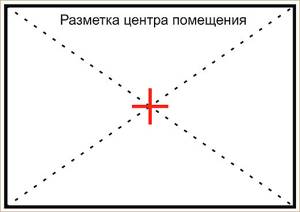
The glue is applied to the parts in a special way - along the edges in a broken line, and in the central part of the part - in large strokes. After this, the slab is pressed against the ceiling and held until the composition firmly fixes it. You can move on to the next element and follow the same pattern.
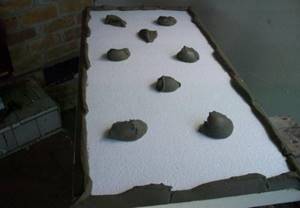
After the entire plane is covered with foam parts, they can be additionally secured with dowels with a wide head, and the seams are filled with sealant or polyurethane foam.



